Poker Tutorial: How to Play Poker
Mastering poker is crucial for both novice and experienced players aiming to improve their game. Casino Mavens' poker tutorial provides a comprehensive guide covering everything from basic rules and hand rankings to advanced strategies and betting techniques. This tutorial is designed to help players enhance their skills, make informed decisions, and increase their chances of winning.
Poker Rules:
Learn the fundamental rules of popular poker variants.
Hand Rankings:
Understand the hierarchy of poker hands from high card to royal flush.
Betting Structures:
Explore different betting formats like No-Limit, Pot-Limit, and Fixed-Limit.
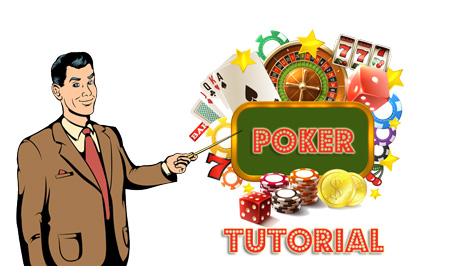
Poker History
According to the British actor Joseph Crowell, the history of poker dates back to 1829 in Louisiana. The game was played between 4 players with 20 decks of cards. According to the book “An Exposure of the Arts and Miseries of Gambling” by Jonathan H. Green, the game started spreading from New Orleans to other areas of the United States. The game traveled with the boats of the Mississippi River. These boats had a reputation for having a lot of gambling activities onboard.
The game as we know it today was not the same as it was in those times. It evolved and went through several phases, specifically during the Civil War in the United States. These phases and circumstances resulted in multiple versions of the game, including Stud Poker and Straight Poker. Other versions came about with the introduction of new concepts like the wild card, community card, lowball, and split-pot poker.
The popularity of poker started to increase more rapidly in 1970. This is when the first-ever World Series of Poker (WSOP) took place. This was the first poker competition to be held on a broad scale, and it was staged annually at Binion’s Horseshoe Casino in Las Vegas. Those who won the WSOP’s Main Event in these early days included some of the biggest names in the poker world, like Bobby Baldwin, Puggy Pearson, Amarillo Slim Preston, and Doyle Brunson. Doyle Brunson went on to win 10 WSOP gold bracelets and is the author of the first book about poker strategy, called “Super / System.”
Poker Popularity Hits the Mainstream
By the 1980’s mainstream media capitalized on the popularity of poker. In the press, poker was portrayed and viewed as a recreational activity. It even appeared in over 10 episodes of the hit sci-fi TV show “Star Trek.” It was a weekly game the senior staff onboard the fictional spaceship enjoyed.
In the 1990s, poker rose to new heights when gambling spread in the United States. It was highly popular in Atlantic City, which at the time quickly became the nation’s second-biggest market, with Las Vegas being first.
The game truly boomed during the first years of the 21st century. A direct result of a perfect storm of three factors: hole-card cameras that allowed viewers to “play along from home” for the first time while watching televised poker, the advent of online poker, and the marquee victory of a Tennessee accountant named Chris Moneymaker in the 2003 WSOP Main Event. Online poker, in particular, helped the spread of the game to anyone who had a computer. Players were no longer obligated to leave their homes and find a brick-and-mortar poker room or home game to enjoy playing. As for the hole-card cameras, they single-handedly turned poker from a card game one could only play into a spectator sport that you could watch, enjoy, and be entertained by, all while rooting for and learning from the game’s best players.
Besides the WSOP, other poker tours started to capitalize on the game’s popularity. The World Poker Tour and the European Poker Tour are just two examples. On April 29, 2009, The International Federation of Match Poker (IFMP) was founded in Lausanne, Switzerland as the first poker governing body. They continue to work towards recognizing Poker as a Mind Sport, as well as securing the legislation that promotes the safety and legality of those playing poker both online and in bricks & mortar organizations.
How to Play Poker
How to play poker depends on the version itself. Different versions of poker have different gaming and dealing procedures and different wagering rounds. So to cater to the needs of all poker aficionados, we will discuss the gaming process of four of the most popular poker versions.
Straight Poker:
There is not much skill or decision-making needed in Straight Poker. In this game, each player will place an Ante bet and is dealt 5 cards. A wagering round will then begin, and players will raise and re-raise or fold. When the wagering round is over, each player will show his/her 5 cards. At the showdown, the highest poker hand will win and scoop the pot.
Texas Hold’em Poker:
Texas Hold’em Poker is one of the most popular poker games in the world, both online and in brick and mortar poker rooms around the globe. It’s also the type of poker that dominates television coverage.
The game starts with the two players seated to the left of the button (dealer position) each placing a blind (bet). They will then be dealt two cards each, which will only be seen by themselves. A wagering round will then be held in which players to the left of the blinds consecutively decide whether to call, raise, or fold their holdings. After that, the dealer will deal the flop, which consists of three community cards dealt on the poker table.
Another betting round will commence among the remaining participants in the hand. Starting with the first player still active left of the button. A fourth card (the turn) is then dealt, then another wagering round occurs, and then the last card (the river) is dealt. Finally, the last (and usually the most aggressive) betting round will take place. The remaining players will then reveal their two cards. Then the player with the best 5-card hand combined from their holdings and the board of community cards will win the pot.
7-Card Stud Poker:
This game was the most widely played poker game in the world before it was overtaken by Texas Hold’em Poker. In 7-card stud poker, players will start the game by placing an ante, and they will also get 2 down-facing hole cards like in Texas Hold’em as well as one face-up card. The player with the lowest face-up card must make a forced “bring-in” bet. In consecutive fashion, players can then choose to call, raise, or fold. Another face-up card is then dealt. The player with the highest-ranking face-up cards starts the wagering moving forward. A third and then a four face-up card is dealt, with wagering rounds in between.
Finally, a third face-down card is dealt to all remaining participants, followed by one final betting round.
It’s worth noting that all betting in 7-Card Stud Poker is made according to fixed limits (rather than “No-limit” or “Pot-limit” play. After the final wagering round, players will reveal their hole cards, and the best five-card hand-formed will win. This game can also be played “hi/low” with half the pot being awarded to the player with the highest hand and the other half of the pot being awarded to the player with the lowest qualifying hand (having five unpaired cards each of which have a value of 8 or lower).
5-Card Draw Poker:
5-Card draw poker is the version of the game that was adapted to video poker. In this game, players will be dealt 5 cards at once, face-down. A wagering round will take place, then players will select the cards they want to discard and replace. They toss them back to the dealer and get replacement cards to form their final 5-card poker hand. A final wagering round will take place before the showdown.
Poker Rules
The rules of poker are pretty straightforward, but they do differ from one version of the game to another. The basic rules remain the same across games, like the ranking of the poker hands. Not knowing which hand is stronger can result in a disaster at the poker table. You could be prone to losing your entire stack of chips…by accident!. Please find below the order of the different poker hands from the lowest to highest:
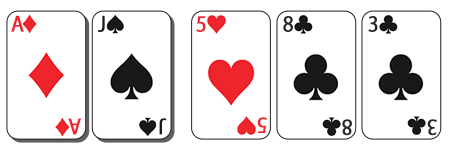
High Card:
A High Card hand will win a pot if no players have any poker hand with a ranking of one pair or higher. The strength of the high card against the same high card depends on the kicker, which is the second card in value. For example, a hand that has an Ace and a Jack will beat a hand that has an Ace and a 9 because it has an Ace High Card and a Jack kicker.
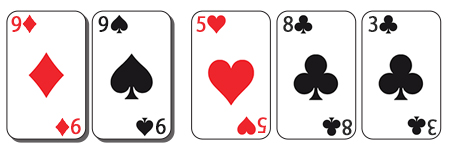
A Pair:
If a poker hand has two cards of the same denomination, it is a pair. The kicker also determines the strength of the pair against the same pair in the same way as the High Card.
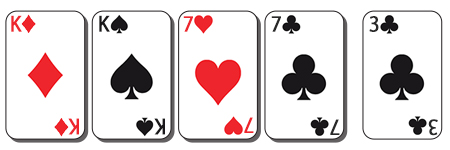
Two Pairs:
When a player has two pairs in his/her hand, the fifth card is the kicker which would indicate the winner between two identical two-pair hands.
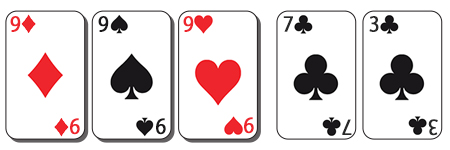
Three of a Kind:
A Three of a Kind is when a poker hand has three identical cards. For example, a hand that consists of J, J, K, J, and Q is a Three of a Kind hand.

A Straight:
A Straight is when a player gets 5 consecutive cards in his/her poker hand, regardless of their suit. An example is a hand with 4, 5, 6, 7, and 8.
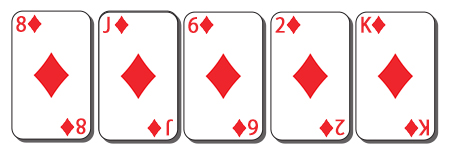
A Flush:
Players have a flush when they get 5 cards of the same suit, regardless of their value. In other words, a hand that consists of (for example) J, K, 6, 5, and 4 of spades makes a flush. The strength of the flush against other flushes depends on the highest card in hand.
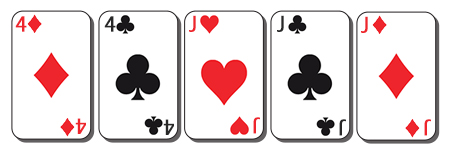
Full House:
This indicates a mixed hand with both a pair and a three-of-a-kind. Players must get 2 and 3 identical cards to qualify as a full house, such as a hand of J, J, K, K, and K.
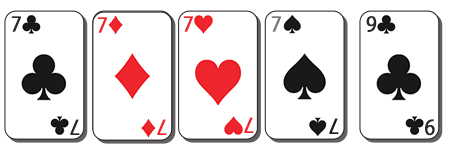
Four of a Kind:
This is achieved when players get four identical cards. There is another similar hand that is called Five of a Kind, which can only be possible if there is a joker or wild card in the deck of cards. Four identical cards + a joker/wildcard will form Five of a Kind.
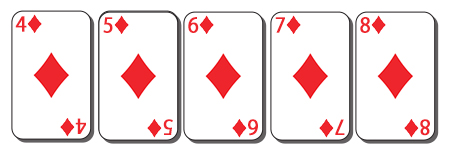
A Straight Flush:
A mix between Flush and Straight. It occurs when players get 5 cards that are consecutive in value. As well as of the same suit, for example, 7, 8, 9, 10, and J of diamonds.
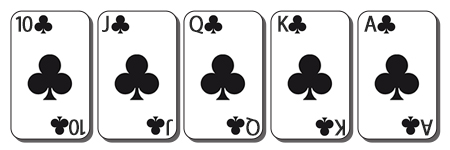
Royal Flush:
This hand is achieved when players get a straight flush that starts with a Ten and goes up to an Ace. For example, a poker hand of 10, J, Q, K, and A of Spades would be a Royal Flush. This is the strongest poker hand possible (again, unless there are jokers/wild cards in play that would allow for a Five of a Kind hand).
Poker Odds
The concept of poker odds comes into play when trying to calculate your chances of winning the hand versus those of your opponents. To understand and know your poker odds, you must calculate the “outs”. The “outs” are the cards that will improve your hand and make it a winning one. If you have a hand of 3, 4, 5, 6 and you think the other player has two Aces; you need a 2 or a 7 so you can achieve a straight and thus win. So 2s and 7s are your “outs.”
For Example: You have two cards in your hand that are Qh9h, and the board on fourth street reads AhKhXX (X means any random card). Your opponent at this stage of the hand will likely have you beat. If you catch one of your “outs” (a heart), you will have the nuts; i.e., the best possible hand in this situation, a flush.
Every card deck contains 13 cards of the same suit: you have two of them in your hand, and the board has another two, which means there are 9 hearts left in the deck. Thus, you have 9 “outs.”
Now it is time to turn these “outs” into numerical odds so you can make a decision. Since there are 52 cards in the deck and you have 2 cards in your hand, and there are four on the table, that leaves 46 cards (we ignore what the other players are holding).
That means that you have 9 cards out of 46 possible cards that could complete your flush for the win while there are 37 cards that would not complete your flush. The odds of you getting a winning card on the river are 37:9. This can be simplified to approximately 4 to 1. Therefore, you are 4 times more likely to lose the hand than win it.
To Call the Bet or Not?
Now that we know your odds of winning are 4:1, the next decision is whether to call the bet or not. Making the correct decision depends on the amount of money in the pot. This does not mean you should automatically go for it if the pot is big. But rather that you should look at the ratio of the money you would win compared to the size of the bet you are thinking of calling. So if your opponent bets $10, making the pot $100, you have the chance to call $10 on 4:1 odds to win $100. You should always call in such a situation simply because, 4:1 odds means you will win $40 for $10, while you are getting odds to win at 10:1. This type of calculation is referred to as knowing your “pot odds.”
Poker Strategy
Poker is a game of decisions, and you will have to make the correct decisions to win consistently. Even the best poker players lose quite often, so do not give up when you lose a few hands. You will win more often than you lose if you make good choices. Even players who have made it to “The Hall of Fame” are still constantly working on improving their poker game.
Poker is a mathematical game that offers players incomplete information. Although that might sound a little complicated, it is not. On a basic level, winning a poker hand starts with selecting which starting hands to continue playing. If you hand-select properly and enter the fray with a good hand more often than the other players do it would mean that you would essentially, win more often than they do.
The starting hands are very important. However, it is only one piece of the poker strategy puzzle. After deciding which hands to play, you will also have to know how to play that good hand, when to raise, when to call, and even when to fold — even if you have a good hand. You will have to calculate the odds, recognize the betting patterns of other players, use your position, and bluff. All of these need years of practice to perfect. Mastering these skills requires not just practice, but also patience and the ability to learn from both wins and losses. For those wondering how to start playing poker, it’s essential to begin with the basics and gradually build your understanding of the game’s strategic layers. Over time, combining knowledge, experience, and calculated risk-taking will help you become a stronger and more confident player.
Don’t Become Emotional
Emotions can ruin your poker game. Some players might try to get on your nerves or use your emotions against you; to put you on tilt. You should always keep calm and avoid any emotional play. Being emotional will cause you to make bad decisions that are based on emotions rather than numbers. For example, if you are on a losing streak, other players might start to needle you knowing you are already on edge because of the losing streak. This could cause you to make poor plays and bad decisions because you are frustrated at losing and trying to recoup your losses. If that happens, leave the game to cool off for a bit. The game will still be there in a couple of hours. It is going to be there tomorrow as well. Clear your mind before you start playing again.
Bluffing
It takes tons of practice to know how to integrate proper bluffing strategies into your poker game. You need more than just the ability to maintain a good poker face. Having a good poker face means keeping the same facial expressions regardless of whether you have a good or bad hand, so players will not know when you are bluffing. Bluffing means you will bet, raise, or even go “all-in” despite not having the best hand.
Basically, the aim of a bluff is to get players with superior holdings to fold out of fear that your holdings are actually more superior to theirs. You should never bluff with reckless abandon. Choose your bluffing spots wisely, as your opponents are continually learning and improving their reads on you. The most effective bluffs are those made when the conditions correctly warrant them. Pay attention to everything going on at the table, the board textures, and how emotional your opponents are getting, and bluff (or choose not to bluff) wisely.
What’s Next?
Now that you understand the rules, odds, types, and overall poker strategy, it’s time to find a room that offers paid or free poker online! Head on over to our poker rooms page to find the best online poker games. Good Luck!
Every gambling site we assess offers a variety of table games, including poker, baccarat, blackjack, roulette, keno, and more. You’ll also find games like slots and video poker. While sports betting is a different form of gambling where you wager bets on sports games and their outcomes, it is quickly rising in popularity. Some casino sites offer it in addition to their game portfolios.
Table of Contents
Our Favorite Online Casino
Discover our top pick for online casinos, featuring user reviews, ratings, and exclusive bonuses.
Slots.LV
Slots.lv Casino is a popular online casino known for its extensive game library, excellent customer service, and fast payouts. It offers over 400 games including slots, table games, and live dealer options, and provides generous bonuses such as a welcome bonus up to $3,000 and a loyalty rewards program. The casino ensures a secure gaming environment with advanced security measures and 24/7 customer support.
What’s included
Extensive Game Selection
Generous Bonuses
Excellent Customer Service
Secure Gaming Environment
BONUS
$3000 chips
Sign Up NowWe may receive affiliate commissions if you sign up for a casino through our links.



